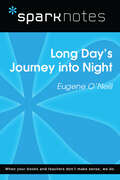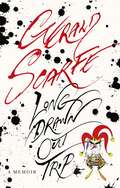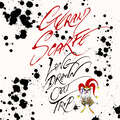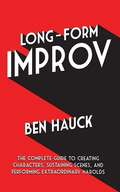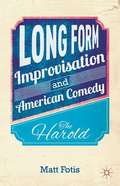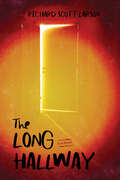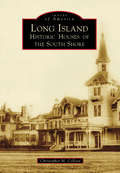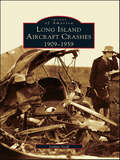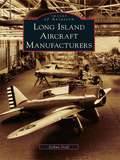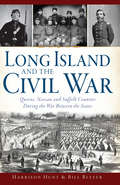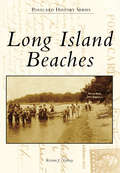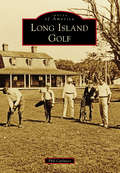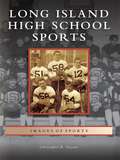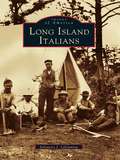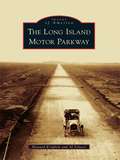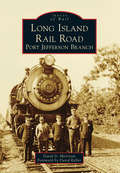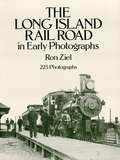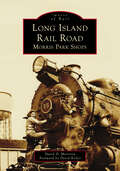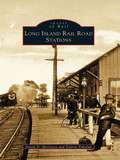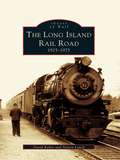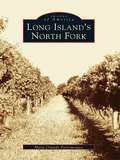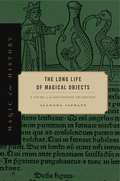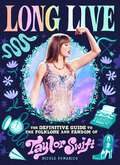- Table View
- List View
Long Day's Journey Into Night (SparkNotes Literature Guide Series)
by SparkNotesLong Day's Journey Into Night (SparkNotes Literature Guide) by Eugene O'Neill Making the reading experience fun! Created by Harvard students for students everywhere, SparkNotes is a new breed of study guide: smarter, better, faster. Geared to what today's students need to know, SparkNotes provides: *Chapter-by-chapter analysis *Explanations of key themes, motifs, and symbols *A review quiz and essay topicsLively and accessible, these guides are perfect for late-night studying and writing papers
Long Drawn Out Trip: A Memoir
by Gerald ScarfeIn Long Drawn Out Trip: My Life, Gerald Scarfe tells his life story for the first time. With captivating, often thrilling stories, he takes us from his childhood and early days at Punch and Private Eye, through his long and occasionally tumultuous career as the Sunday Times cartoonist, to his film-making at the BBC and much-loved designs for Pink Floyd's The Wall and Disney's Hercules. Along the way he has drawn Churchill from life, gone on tour with The Beatles and thoroughly upset Mrs Mary Whitehouse. It is a very personal, wickedly funny and caustically insightful account of an artist's life at the forefront of contemporary culture and society.
Long Drawn Out Trip: A Memoir
by Gerald ScarfeIn Long Drawn Out Trip: My Life, Gerald Scarfe tells his life story for the first time. With captivating, often thrilling stories, he takes us from his childhood and early days at Punch and Private Eye, through his long and occasionally tumultuous career as the Sunday Times cartoonist, to his film-making at the BBC and much-loved designs for Pink Floyd's The Wall and Disney's Hercules. Along the way he has drawn Churchill from life, gone on tour with The Beatles and thoroughly upset Mrs Mary Whitehouse. It is a very personal, wickedly funny and caustically insightful account of an artist's life at the forefront of contemporary culture and society.
Long Drawn Out Trip: A Memoir
by Gerald ScarfeIn 1964 a young artist sat in the public gallery of the House of Commons, sketching former Prime Minister Winston Churchill. The Sunday Times refused to print the resulting drawing of this frail, aged figure - so far from the public image of the man - it was too truthful.In the sixty years since, Gerald Scarfe's work has continued to expose the truth, and has appeared many times in the pages of the Sunday Times, in the Evening Standard, New Yorker, Private Eye and Time, as well as on the walls of the V&A and the Tate, the stages of the English National Opera and the English National Ballet, and cinema screens around the world in the form of Pink Floyd The Wall and Disney's Hercules.In Long Drawn Out Trip, Gerald tells his life story for the first time. With captivating, often thrilling stories, he takes us back to his wartime childhood and the terrible curse of asthma, through his days as an advertising draughtsman, to his field reporting in Vietnam and the giddy highs of rock 'n' roll. He also reveals the process of cartooning - and the ways that certain subjects have reacted to his visions of them. Along the way he has been car-jacked in Derry, dined with royals, and thoroughly upset Mrs Mary Whitehouse. It is a very personal, wickedly funny and caustically insightful account of an artist's life at the forefront of contemporary culture and society.
Long-Form Improv: The Complete Guide to Creating Characters, Sustaining Scenes, and Performing Extraordinary Harolds
by Ben HauckLong-Form Improv deftly teaches the wildly popular form of improvisation that is so foundational to the comedy stylings of many of today's top actors and thriving comedians. Crammed with innovative ideas for conceptualizing improvised scenework and "finding the game of the scene," this crisply written manual covers techniques for experienced improvisers, curious actors, and even non-actors. A complete long-form improv resource comprising topics like ideation and character creation, improvising scenes for extended periods of time and enhancing them--and even performing the most famous expression of long-form improv, the half-hour improvised form known as "The Harold"--this astute text is written in a friendly, supportive voice by an experienced improv teacher and professional actor whose own frustration in learning the craft drove an obsession to create a program free of confounding teachings and contradictory concepts. The book's groundbreaking infusion with drama theory and game theory brings new life to the teachings of the craft, breaking down various aspects of long-form improv into short chapters for swift, step-by-step intake of its vital lessons. Students of acting and long-form improv alike should expect Long-Form Improv to bolster their education and fast-track their course to improv greatness.
Long Form Improvisation and American Comedy
by Matt FotisLong form scenic improv began with the Harold. The comic philosophy of this form started an era of comedy marked by support, trust, and collaboration. This book tells of the Harold, beginning with the development of improv theatre, through the tensions and evolutions that led to its creation at iO, and to its use in contemporary filmmaking.
The Long Hallway (Living Out: Gay and Lesbian Autobiog)
by Richard Scott LarsonGrowing up queer, closeted, and afraid, Richard Scott Larson found expression for his interior life in horror films, especially John Carpenter’s 1978 classic, Halloween. He developed an intense childhood identification with Michael Myers, Carpenter’s inscrutable masked villain, as well as Michael’s potential victims. In The Long Hallway, Larson scrutinizes this identification, meditating on horror as a metaphor for the torments of the closet. Larson was only nine years old when he recognized something of his own experience in how Michael Myers hid his true face from the world. This spark of recognition ignited his imagination while he searched for clues to what the future might hold for boys like him, all the while being made to understand his nascent sexuality as deviant and punishable. Like in the movies, his superficially safe suburban childhood was in fact filled with threat: a classmate’s murder, his father’s alcoholism and death, and his own sexual assault by a much older man. The figurative mask Larson learned to wear could not contain his yearning to be seen and desired. In the aftermath of this violence, his boyhood self came to believe that fear and desire would be forever intertwined. This lyrical memoir expresses a boy’s search for identity while navigating the darkness and isolation of a deeply private inner world. With introspection and tenderness, Larson reflects on how little we understand in the moment about the experiences that mark us forever.
Long Island: Historic Houses of the South Shore (Images of America)
by Christopher M. ColloraIn contrast to and predating Long Island's famous Gold Coast (the North Shore), communities along the Great South Bay were home to hundreds of less publicized, yet equally impressive, mansions and historic houses. These homes were once owned by prominent captains of industry, popular entertainment figures, and movers and shakers of the day, such as the Bourne, Cutting, Gardiner, Gulden, Gustivino, Guggenheim, Hollins, and Vanderbilt families. Long Island: Historic Houses of the South Shore explores the South Shore's famous resident personalities, including Schuyler Parsons, Fred Astaire, Anita Stewart, and Robert Pinkerton. The lifestyle of the South Shore is also portrayed, including activities like hunting and fishing as well as the famous beaches that served as tourist attractions.
Long Island Aircraft Crashes: 1909-1959
by Joshua StoffDuring the first fifty years of American aviation, Long Island was at the center of aircraft innovation and flight. There were more aircraft manufacturers and airports located on Long Island than in any other part of the United States. Due to the extraordinarily high volume of air traffic, Long Island also led the country-if not the world-in aircraft crashes. Long Island Aircraft Crashes: 1909-1959 portrays the daring flights, accidents, and mishaps of pioneer pilots, and the conditions that contributed to many crashes. Long Island ultimately saw the earliest air-traffic control systems, airport lighting, aviation weather reports, paved runways, and professional flight schools. Long Island Aircraft Crashes: 1909-1959 contains captivating images from Mitchel Field and Roosevelt Field, the two most active airfields on Long Island. In addition to airfield activity, this book illustrates some of the first experimental flights over Hempstead Plains; military training at Hazelhurst Field; the L.W.F. Owl bomber (the largest landplane of its time); the world's first instrument-guided flight; and Amelia Earhart posing with the new Sperry Gyropilot.
Long Island Aircraft Manufacturers (Images of Aviation)
by Joshua StoffSignificant aircraft manufacturing began on Long Island in the early 20th century and boomed during the war years. Long Islanders helped transform aviation from a dangerous sport to a viable means of transportation, while also producing a large portion of the nation's aerial arsenal in times of war. From the first frail biplanes to the warbirds of World War II and the sleek fighters of the jet age, aviation companies on Long Island helped make aviation the integral part of our world that it is today. During the 20th century, over 70 firms came to build aircraft on Long Island. Some of these firms lasted for decades and became famed builders of historic aircraft, such as Grumman, Republic, Curtiss, Fairchild, and Sikorsky.
Long Island and the Civil War: Queens, Nassau and Suffolk Counties During the War Between the States (Civil War Series)
by Harrison Hunt Bill BleyerAlthough no battles were fought on Long Island, the Civil War deeply affected all of its residents. More than three thousand men--white and black--from current-day Queens, Nassau and Suffolk Counties answered the call to preserve the Union. While Confederate ships lurked within eight miles of Montauk Point, camps in Mineola and Willets Point trained regiments. Local women raised thousands of dollars for Union hospitals, and Long Island companies manufactured uniforms, drums and medicines for the army. At the same time, a little-remembered draft riot occurred in Jamaica in 1863. Local authors Harrison Hunt and Bill Bleyer explore this fascinating story, from the 1860 presidential campaign that polarized the region to the wartime experiences of Long Islanders on the battlefield and at home.
Long Island Beaches (Postcard History Series)
by Kristen J. NyitrayFor centuries, Long Island's beaches have provided sustenance, relaxation, and inspiration. The coastline is renowned for its sandy Atlantic Ocean surf beaches, calm bayfront beaches, and rugged north shore Long Island Sound beaches. First inhabited by Native Americans, the area was called Sewanhacky ("Isle of Shells") in reverence to the offerings received where the water met the land. Drawing from the archives of local libraries, historical societies, museums, and private collections, Long Island Beaches presents a curated selection of vintage postcards illustrating the diversity of Nassau and Suffolk Counties' beautiful shores. Rare photographs and maps accompany the postcards to provide historical context. Through extensive research, author Kristen J. Nyitray documents a facet of Long Island's social and cultural history and the lure of its picturesque beaches.
Long Island Golf (Images of America)
by Phil CarlucciWhen the European sport of golf found its way to Long Island and took root in the Hamptons at Shinnecock Hills in 1891, its journey across the Atlantic served as the opening drive of a recreational era that now spans three centuries. Home to more than 130 golf courses, the area boasts prestigious American clubs overlooking picturesque Atlantic bays and inlets, along with public layouts climbing and descending the region's sloping terrain. Long Island is home to the most popular municipal golf facility in the country, the centerpiece of which is Bethpage Black, "the People's Country Club." Celebrated architects like A.W. Tillinghast, Devereux Emmet, Seth Raynor, and C.B. Macdonald built many of Long Island's famous courses, which have challenged the brightest of golf's stars. International tournaments and star-studded exhibitions have all been decided on Long Island turf, helping it grow into one of the world's most prominent golf settings.
Long Island High School Sports (Images of Sports)
by Christopher R. VaccaroFor nearly 120 years, Long Island has fielded high school sports teams. In that span, numerous local athletes rose to the highest level, dynasties were built, legends were made, and the nation's largest island was filled with captivating athletic stories and sports lore that will live forever. Long Island High School Sports strings together a pictorial history of Long Island's oldest, most famous, and well-respected teams, coaches, and athletes.
Long Island Italians (Images of America)
by Salvatore J. LaguminaIn America "the streets were paved with gold." That was the mistaken notion of many an immigrant to the United States in the late 1800s and early 1900s. On Long Island, deluded sojourners from Italy were to find that in fact there were few streets and that they themselves were to be the ones to build them.Covering more than a century of history, Long Island Italians depicts the transition of urban Italians as they moved increasingly from the city to the suburbs in Nassau and Suffolk Counties. They were attracted to Long Island by economic opportunity, the availability of arable land, home ownership possibilities, and alternatives to harsh city life. There, they became the largest of all ethnic groups, with more Americans of Italian descent living in one concentrated area than anywhere besides Italy. The Italian American presence is a continuing phenomenon, today comprising about 25 percent of the total population of Long Island. Long Island Italians graphically illustrates that Italian laborwas vital to the development of Long Island roads, agriculture, railroads, and industry. By the early twentieth century, Italians made up the bulk of the work force. The book goes beyond the laborers to show also the warmth of Italian family life, the strength of the social organizations, and the rise of the politicians.
Long Island Motor Parkway, The (Images of America)
by Howard Kroplick Al VelocciA forerunner of the modern highway system, the Long Island Motor Parkway was constructed during the advent of the automobile and at a pivotal time in American history. Following a spectator death during the 1906 Vanderbilt Cup Race, the concept for a privately owned speedway on Long Island was developed by William K. Vanderbilt Jr. and his business associates. It would be the first highway built exclusively for the automobile. Vanderbilt's dream was to build a safe, smooth, police-free road without speed limits where he could conduct his beloved automobile races without spectators running onto the course. Features such as the use of reinforced concrete, bridges to eliminate grade crossings, banked curves, guardrails, and landscaping were all pioneered for the parkway. Reflecting its poor profitability and the availability of free state-built public parkways, the historic 48-mile Long Island Motor Parkway closed on Easter Sunday, April 17, 1938.
Long Island Rail Road: Port Jefferson Branch
by David D. Morrison David KellerThe Long Island Rail Road is the oldest railroad in the country still operating under its original name. As the busiest railroad in North America, it carries 265,000 customers each weekday aboard 735 trains on 11 different branches. The Port Jefferson Branch serves 10 stations from Hicksville to Port Jefferson and carries nearly 20 percent of the railroad's passenger traffic over its 32 miles of track. Hicksville Station is the site of the October 8, 1955, "End of Steam Ceremony," when steam locomotives were retired from service. The oldest surviving station building constructed by the Long Island Rail Road is on this branch at St. James. Between 1895 and 1938, the branch extended 10 miles east to Wading River. The branch was not electrified until 1970 and that was only to Huntington Station, east of which is served by diesel and dual-mode locomotives.
The Long Island Rail Road in Early Photographs (Dover Transportation)
by Ron ZielFascinating text-and-photo documentary details economic, social upheaval following inauguration of Long Island Rail Road's service in 1844. 225 rare photos provide splendid views of early coaches, locomotives, snow-removal operations, stations, passengers, crew, much more. Extensive captions.
Long Island Rail Road: Morris Park Shops (Images of Rail)
by David D. MorrisonDavid D. Morrison, retired Long Island Rail Road (LIRR) branch line manager and railroad historian, has compiled rare photographs to showcase the shops that power the LIRR, the busiest railroad in North America. The LIRR provides passenger rail service from Midtown Manhattan to to the far ends of Long Island at Greenport and Montauk. A vast operation such as this requires a huge fleet of locomotives and cars. The reliability of the fleet rests mainly upon the shop maintenance facility. The Morris Park Shops, opened in 1889 and closed in the early 2000s, provided over a century of maintenance and repair service, allowing the LIRR to develop and expand through the years. The complexity of the shop facility, from the days of steam locomotives to multiple-unit electric cars and diesel locomotives, is a fascinating chapter in LIRR history.
Long Island Rail Road Stations
by David D. Morrison Valerie PakalukChartered in 1834 to provide a route between New York City and Boston, the Long Island Rail Road ran from the Brooklyn waterfront through the center of Long Island to Greenport. The railroad served the agricultural market on Long Island until branches and competing lines eventually developed on the north and south shores of the island and several hundred passenger stations were built. After Penn Station was opened in 1910, the number of passengers commuting between Manhattan and Long Island began to multiply. Today, one hundred twenty-five stations serve the Long Island Rail Road. Long Island Rail Road Stations contains vintage postcards of the old Penn Station, which was demolished in the mid-1960s; the Grand Stairway at the Forest Hills Station, where Theodore Roosevelt delivered his famous unification speech on July 4, 1917; and the Amagansett station building, where Nazi spies boarded a train bound for New York City on June 13, 1942. Many of the historic stations featured in this book have been preserved by local preservation groups, while others have been replaced with modern buildings to accommodate the passengers who commute on the nation's largest commuter railroad.
Long Island Railroad, The: 1925-1975
by Steven Lynch David KellerChartered on April 24, 1834, as a route from Brooklyn to Boston, the Long Island Rail Road commenced in 1836 with service between Brooklyn and Jamaica, New York. The railroad has linked Long Island and New York City through several periods of increasing immigration and population beginning in the 1880s. Farmers and fishermen have depended on the railroad for their livelihood, and every summer thousands of tourists flock to Long Island beaches on the Long Island Rail Road. It is still the nation's largest commuter railroad, transporting an average of over two hundred fifty thousand commuters daily. The Long Island Rail Road: 1925-1975 offers a behind-the-scenes look at freight and passenger activities and the people who worked on the railroad. These one-of-a-kind photographs depict structures no longer in use, such as towers, water tanks, and crossing shanties, as well as electric motive power and other facets of a working railroad.
Long Island's North Fork (Images of America)
by Maria Orlando PietromonacoBoasting a verdant landscape and miles of silky white beaches, Long Island's North Fork remains a natural paradise. Escaping the urbanization that overspread much of Long Island in the early 1900s, the rural villages survived on farming, fishing, shipbuilding, and maritime trading. Loyal residents have preserved the North Fork's rich heritage and tranquil pace of life. Thus, agriculture still thrives and boats continue to cruise the crystal-clear waters.Long Island's North Fork explores the past through the eyes of those who lived in the rustic countryside. It is a treasury of photographs, many taken by professionals, others from selected family albums and collections.
The Long Life of Magical Objects: A Study in the Solomonic Tradition (Magic in History)
by Allegra IafrateThis book explores a series of powerful artifacts associated with King Solomon via legendary or extracanonical textual sources. Tracing their cultural resonance throughout history, art historian Allegra Iafrate delivers exciting insights into these objects and interrogates the ways in which magic manifests itself at a material level.Each chapter focuses on a different Solomonic object: a ring used to control demons; a mysterious set of bottles that constrain evil forces; an endless knot or seal with similar properties; the shamir, known for its supernatural ability to cut through stone; and a flying carpet that can bring the sitter anywhere he desires. Taken together, these chapters constitute a study on the reception of the figure of Solomon, but they are also cultural biographies of these magical objects and their inherent aesthetic, morphological, and technical qualities.Thought-provoking and engaging, Iafrate’s study shows how ancient magic artifacts live on in our imagination, in items such as Sauron’s ring of power, Aladdin’s lamp, and the magic carpet. It will appeal to historians of art, religion, folklore, and literature.
The Long Life of Magical Objects: A Study in the Solomonic Tradition (Magic in History)
by Allegra IafrateThis book explores a series of powerful artifacts associated with King Solomon via legendary or extracanonical textual sources. Tracing their cultural resonance throughout history, art historian Allegra Iafrate delivers exciting insights into these objects and interrogates the ways in which magic manifests itself at a material level.Each chapter focuses on a different Solomonic object: a ring used to control demons; a mysterious set of bottles that constrain evil forces; an endless knot or seal with similar properties; the shamir, known for its supernatural ability to cut through stone; and a flying carpet that can bring the sitter anywhere he desires. Taken together, these chapters constitute a study on the reception of the figure of Solomon, but they are also cultural biographies of these magical objects and their inherent aesthetic, morphological, and technical qualities.Thought-provoking and engaging, Iafrate’s study shows how ancient magic artifacts live on in our imagination, in items such as Sauron’s ring of power, Aladdin’s lamp, and the magic carpet. It will appeal to historians of art, religion, folklore, and literature.
Long Live: The Definitive Guide to the Folklore and Fandom of Taylor Swift
by Nicole PomaricoThis lushly illustrated package is the ultimate fan guide for Swifties! It covers the Taylor Swift multiverse from all angles with a journey through fandom history, exclusive interviews, and behind-the-scenes detail on her career across eras, including The Tortured Poets Department. Whether you&’ve been with Taylor from the start or are a new fan, this guide is for you. Use it to catch up on all the lore and inside jokes from the beginning, or to discover forgotten details from the past. From MySpace comments to T-Party invites to Secret Sessions and beyond, Long Live explores the evolution of Taylor as well as the ride that fans have been on with her through two decades of personal milestones—hers and ours, both good and bad. With Long Live you&’ll: Take a trip through Taylor&’s eras from the start of her career, with stops at each album and its iconic songs, the hidden Easter Eggs, and relationships that have informed the star&’s music. Have fun looking back on concert traditions and inside jokes, roll your eyes at the most embarrassing clowning moments, take in era-specific Swiftie style lessons, read exclusive stories of fan encounters and author Nicole Pomarico&’s own experiences meeting Taylor Swift and her parents. Be amazed by how the relationship between Taylor and her fans has been so well nurtured that it has become a cultural force building the career of one of the biggest stars of all time. Featuring stylish illustrations and photos throughout, this is an essential look at the artist&’s career and fandom. The complete package for Taylor Swift fans!
